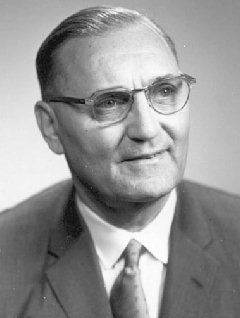 |
Idea
Man: John Josef Grebe
Dow |
Dow Chemical
and the scientific analysis of UFO debris
One of the most famous and puzzling incidents in UFO history is the 1957 Ubatuba, Brazil case, in which debris said to have been retreived after the explosion of a UFO was determined to be magnesium metal of unusual composition.
See: Jerome Clark on the Ubatuba UFO Debris Case
But there is another, surprisingly similar incident that occurred in the US at the dawn of the modern UFO phenomenon. This incident directly or indirectly involved a host of people and organizations that were later to have a major impact on the study of UFOs in the United States, and points out that there is still much to be learned concerning the early investigation of the phenomenon by the military, the intelligence community and even, perhaps, by the corporate world.
Project Blue Book's detailed case file on the earlier incident tells a weird and fascinating tale. According to Dow documents preserved in the file, the event began just after 5:00 on the afternoon of July 9, 1947, as a forty-five year old electrician named Raymond Lane and his wife were picking huckleberries near Midland, Michigan. A strange sizzling noise abruptly drew their attention to a bizarre mass of bright white, fiery sparks hovering about a foot above the ground and about a hundred feet away. It reminded them of a Fourth of July sparkler, but it was much bigger -- the size, as they later put it, of a bushel basket. The fireball burned brilliantly for about fifteen seconds before dying out. When the smoke drifted away, there was nothing left except some hot, light-and-dark-colored metallic-looking debris on the sandy soil. Lane collected fragments of the material in a tin can and considered whom to tell.
The mysterious fireball had appeared in a uniquely appropriate place. Midland happened to be the home of one of America's most well-equipped materials analysis facilities: the laboratories of Dow Chemical company, well known for its metallurgical expertise and a world leader in magnesium technology.
Shortly after World War I, Dow metallurgists had developed an alloy that the company called "Dowmetal" -- refined magnesium to which was added about six percent aluminum and one-half percent manganese. Dowmetal was widely promoted for automotive and aviation uses and was highly profitable for the company, eventually giving it a virtual monopoly on magnesium production in the US. In 1933 the company was approached by Belgian scientist Jean Piccard with a request to design and build a Dowmetal cabin for a record-setting high-altitude balloon flight. The design was highly successful and eventually enabled flights to over 70,000 feet.
During World War II Dow's extremely lightweight, strong magnesium alloys became an indispensable ingredient of aircraft and missile structures. The company also became a contractor for an unusual flight test program that had a direct link to Project SIGN, the Air Force's 1948 UFO research establishment.
See: Dow and Boundary Layer Control
One of the most significant figures behind Dow's success was a chemist named John Josef Grebe [pronounced "gree-bee"]. Born Hans Josef Grebe in Uerzig, Germany in 1900, he emigrated to Ohio in 1914 and became a US citizen in 1921. Grebe graduated from the Case School of Applied Science in 1924 and was immediately hired by Dow. Considered a genius by his colleagues and known as the "Idea Man," Grebe was given free rein to work on projects of his own devising. He established the company's Physical Research Laboratory, an organization that produced a steady stream of valuable inventions, particularly in the field of plastics. Chemists under his direction were responsible for the discovery of several now-universally used plastics, such as styrene, Styrofoam, and polyvinyl chloride, and also developed a synthetic rubber that was vital to the US military in World War II.
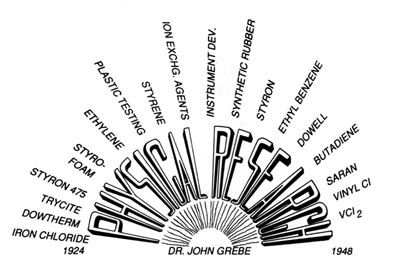 |
A mind like a Sun: Dow illlustration detailing products of Grebe's Physical Research Lab
|
Grebe even perfected a method of extracting magnesium from sea water, a process that became Dow's main source of the metal. After Japan's surrender Grebe was assigned to work with the Oak Ridge nuclear laboratory, and in 1946 he was an observer at the Operation Crossroads nuclear tests. He also worked closely with the US Army's Chemical Corps on the highly classified toxicological and radiological warfare programs (in fact, by 1948, Grebe would be named the Chemical Corps' chief technical advisor).
The morning after the fireball incident, Lane took his can of sandy debris to Robert S. Spencer, a senior researcher in Grebe's laboratory, whom Lane had met when he was a Dow employee some years before. Spencer contacted Edward Fales, the company's internal security chief, and together the men went to the site to investigate. Lane told the Dow officials that he thought the object had been a flying saucer, or possibly a meteorite, and that some small lumps of silvery metal in the debris he had scooped up might be platinum. (Ironically, there is no evidence that he or anyone else ever reported seeing an object in flight prior to the appearance of the fireball). Spencer immediately arranged to have the material analyzed. The Spectroscopy Laboratory quickly reported that the shiny pellets in the material were largely silver mixed with a few percent silicon, which probably came from the sand on which the molten material had solidified. The sample was checked for radioactivity, but did not blacken photographic plates. According to a report by Fales,
Preliminary tests of the material show the contents to be as follows: ordinary sand, not radio active [sic], but giving off an ammonia gas. A silver nugget, almost pure except for sand mixed in it, not radio active. Melted or fused sand which gives off ammonia, has little droplets of silver melted in the sand and some other material which is not radio active. The fused sand has some characteristics of the Los Alamos sand [i.e., the glassy material created by the Trinity nuclear explosion] but is not believed to be the same.
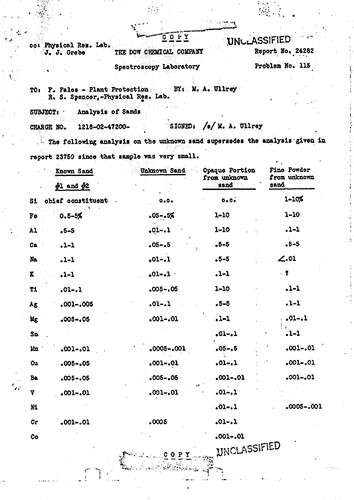 |
A portion of Dow's analysis of the July 9, 1947 'flying saucer debris' from Project Blue Book case file
USAF |
By the end of September the Lab had run more spectrographic tests on a small quantity of a fine, light, ash-like powder laboriously sifted from the debris. The powder turned out to be a material called thorite, which was discovered to be somewhat radioactive. The remaining portion of the debris yielded traces of iron, aluminum, magnesium, and other metals. There was also evidence of a significant amount of magnesium hydroxide, which some analysts took to be the remains of the combustion of a sizable amount of magnesium.
Interestingly, Dow handled the case as a purely internal matter at first. Fales' inquiries concerning Lane led him to conclude that he was a somewhat peculiar individual who was known to have basic technical expertise. On balance, the incident seemed likely to be the result of some kind of home-made fireworks experiment. The FBI was eventually contacted and an agent conducted a basic inquiry. As will be seen, there was no Air Force involvement with the case in 1947.
Activity surrounding the Midland fireball incident became dormant by the autumn of 1947 but was revived dramatically a year later, when on September 17, 1948, Grebe, then working with the Chemical Corps at Edgewood Arsenal, Maryland, requested an update on the investigation from Dow. An examination of Fales' dossier set him to speculating. In an October 11 memo to one of his Army superiors, he wrote that
The only technical point that would tend to discredit the report in a very slight way is that the particular spectrum analysis that was made of the sand that was supposed to have been picked up with the sample of the fused mineral matter, which contained nuggets of silver, had a different analysis from the sand picked up in the general area. It had rained, however, in the meantime, which would remove any magnesium hydroxide that might have been around. As a whole, it would appear to me that, every bit of evidence found should be considered seriously as an indication that a self-consuming missile capable of producing a considerable amount of smoke and fire and leaving behind only the minimum residue required to produce a battery and radio transmitter is feasible and was probably observed.
This concept - that the small Midland fireball had represented the self-destruction of some kind of instrumented projectile - marked a drastic change in the official approach to the incident, bringing it in line with the fears in 1946 and 1947 that some anomalous meteor-like events were actually a type of "self-consuming missile" experiments.
See: Ghost Rockets
See: Green Fireballs
It is not apparent from the available source material exactly why Grebe chose this juncture to reopen the case, but there are indications that similar studies were being performed at the time on other samples of apparent UFO debris that were considered to be possibly the remains of missiles. For example, on November 26, FBI Director J. Edgar Hoover sent a memo to the Air Force's Director of Special Investigations (IG), concerning a case similar to the Midland incident.
Just two days before Lane's 1947 experience, a group of people near the village of West Rindge, New Hampshire had been surprised by the sudden appearance of wisps of smoke and flame rising from nearby lawns and fields. Many small burned areas were discovered to be scattered in a 200-foot diameter circle and seemed to have been caused by hot fragments of metal that apparently had fallen from the sky. A witness turned several of the fragments over to a Professor "Rentges" of the Massachusetts Institute of Technology for analysis. (This was typical phonetic FBI spelling -- "Rentges" was apparently J. Francis Reintjes of the MIT Servomechanisms Laboratory where Project Whirlwind, a powerful digital computer that would become the prototype for the SAGE national air defense network, was under development at the time).
Reintjes expressed the opinion that the material, which had obviously been subjected to "terrific heat," resembled the lining of the rocket engines of German V-2 ballistic missiles he had seen in New Mexico. Four of the collected fragments, when pieced together, appeared to have been part of a hollow cylinder eight inches in diameter and having a wall thickness of three-sixteenths of an inch. The West Rindge material had been subjected to spectrographic analysis recently, Hoover reported, and was determined to be ordinary cast iron that "had been subjected to a very high degree of heat."
Additionally, in a letter titled "Flying Object Incidents in the United States", dated November 3, 1948, Col. Howard McCoy of Air Materiel Command's Technical Intelligence Division informed Chief of Staff General Hoyt Vandenberg that his Project "Sign" flying saucer analysts had interviewed Nobel Laureate Dr Irving Langmuir of General Electric concerning the possible origin of the objects, and that "it is planned to have another interview with Dr. Langmuir in the near future to review all the data now available, and it is hoped that he will be able to present some opinion as to the nature of the unidentified objects, particularly those described as 'balls of light.'" Study of this particular type of flying object - apparently a tiny, remote-controlled or internally-guided probe - had gained urgency after the October 1, 1948 incident in which an Air National Guard pilot had engaged in a long nighttime dogfight over Fargo, North Dakota with a small, fast-moving blinking light that was apparently under intelligent control.
It seems probable that this effort to carefully analyze fragments of suspected flying saucers was part of the escalating attempt to establish whether there was any credible evidence of a foreign terrestrial origin of the objects - an approach that achieved its highest expression with the publication, on December 10, 1948, of the Top Secret Air Intelligence Division Study 203, "Analysis of Flying Object Incidents in the US". This study examined the possibility that flying objects reported over the continental US represented Soviet reconnaissance, training or provocation missions.
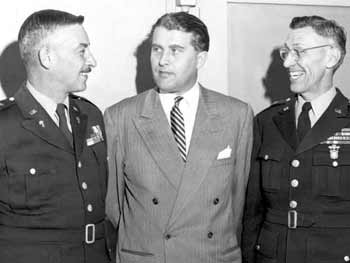 |
Army missile program officers Medaris, left and Toftoy flank Wernher von Braun
US Army |
Meanwhile, John Grebe had taken his theory about the Midland case to the highest levels of Army missile research. In the middle of October he met with Col. Holger Toftoy, Army Ordnance, the commander of Project Hermes, the Army's multifaceted guided missile program based at White Sands, New Mexico. Shortly after the Nazi surrender Toftoy had supervised the removal of some one hundred V-2 missiles from underground factories and had them transported to White Sands. Under Project Paperclip, the German rocket engineers who had created the V-2, including Wernher von Braun, were moved to Fort Bliss to work with Toftoy's Ordnance team and General Electric, the contractor for Project Hermes, in reconstructing and launching the missiles.
See: The Radical Cruise Missile Experiments of Project Hermes II
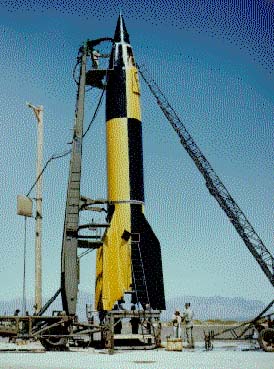 |
V-2 being readied for flight at White Sands, 1946
US Army |
Toftoy's log for October 18, 1948 records Grebe's surprising presentation:
Conference attended by Cols Toftoy, Roberts & Bainbridge (CC), Maj J.F. Gay & Dr. J. J. Grebe, (Chemical Corps), and Dr. Mugson. Chemical Corps reported analysis of fragments picked up from '"flying saucer" which vanished with a brilliant flash and bang near Midlin [sic], Michigan. Sand and clinker recovered from the locality contained nuggets of fairly pure silver and some thorium. The thorium was sufficient to give radio activity [sic] approximately 10 times natural background which could possibly be ascribed to thorium coated filaments in electronic equipment, although the quantity seems excessive. There was evidence also of mechanism [magnesium] which had been completely oxidized. Dr. Grebe advanced his hypothesis that small missiles of the order of 1 to 3 feet in diameter might be responsible, coming from distant sources. He considered that a rapidly rotating disc of mechanism [magnesium] and/or aluminum might have enough energy if properly utilized to propel the disc several thousand miles, and might be completely destroyed by burning in air. Remaining traces of silver and thorium might be ascribed to electronic control system. After discussion, it was agreed that Col Roberts should request the Bur of Standards group to investigate some of the mechanisms which might conceivably propel discs of this general type and TU will keep in close touch with these calculations (CMH). A meeting next Monday, 25 Oct, can be arranged with Dr. Grebe if indications are favorable. Dr. Grebe also briefly described a theory of his that a fish-shaped object with a modified tear-drop cross section would take off along the long axis and change position in flight to fly at an angle more like a flying wing. No wings or other aerodynamic surfaces that produce drag would be required.
Grebe clearly envisioned the Midland object as a small, unmanned vehicle containing 1940s state-of-the-art vacuum tube based electronic equipment (because of the distinctive apparent traces of silver solder and thoriated tungsten tube filaments - an invention of Irving Langmuir), and given that he specified its range as "thousands of miles," he apparently believed that its source was the Soviet Union. The intriguing vision of a fast-spinning, flywheel-like object that would destroy itself at the end of its trajectory was novel, to say the least, but Grebe had a good reason for this idea. One of Dow's most secret and most vital wartime projects had been the development of a structural housing for the miniature radio transmitter that formed the heart of the "VT" - the proximity fuze.
The radarlike VT fuze was designed to detonate an artillery shell at the exact moment that it passed within lethal range of its target, such as an aircraft or missile - or in anti-personnel applications, just as it descended to within a few yards of the ground. To do so, it incorporated a tiny radio transmitter and receiver built from highly miniaturized and ruggedized vacuum tubes. These tubes had to survive shock and acceleration amounting to thousands of g's when fired from a heavy gun, as well as the enormous centrifugal force of the shell's stabilizing spin. Dow's contribution was the design and production of a special plastic housing for the tiny tubes, and the project was carried out in such secrecy that most of the technicians on the project only learned of its exact function at the end of the war.
 |
Plastic-tipped proximity fuze packaged for artillery applications
US Army Ordnance Museum |
The proximity fuze design effort was headquartered at the Johns Hopkins University's Applied Physics Laboratory in Maryland and was directed by Merle Tuve, whose administrative assistant was an astronomer named Josef Allen Hynek. Grebe's saucer concept amounted to something much like an artillery shell, possibly combined with an aerodynamic shape that would allow a degree of flight after the device arrived in the vicinity of its target. The VT shell had incorporated a novel battery that was energized when its chemicals mixed due to the shock of launching, and Grebe believed that the disc-missiles used something similar. Presumably the self-destructing feature would prevent US analysts from recovering intact specimens of the vehicle.
The "Bur of Standards group" referred to in the memo was the National Bureau of Standards' Ordnance Development department, a secret guided missile research establishment operating within the weights-and-measures agency, which had worked closely with the Army and Navy during WWII under the direction of Harry Diamond and Dr. A. V. Astin.
 |
Harry Diamond, far left, with proximity fuzes for mortar and bomb applications
NIST |
The Ordnance department's first products had been highly classified miniature radio components for the proximity fuze. Diamond's group, along with Hugh Dryden, from the Bureau's Mechanics and Sound department, also developed some of America's first "smart weapons" during the war, including the "Robin," a television-guided bomb, the "Pelican," a passive-radar-homing glide bomb, and the "Bat," a 1,000-pound radar-guided anti-ship glide weapon.
 |
Bureau of Standards-designed "Bat" guided bomb mounted on wing of Navy bomber, circa 1945
US Navy |
To help pack more and more electronic components into missiles, the Bureau had perfected increasingly miniaturized vacuum tubes, and by the end of the war, its technicians helped invent a process for literally painting circuitry onto insulating substrates, the forerunner of modern printed circuits.
 |
Miniaturized vacuum tubes, right, compared with standard type
NIST |
The Director of the Bureau of Standards since November 1945 was Edward U. Condon. The New Mexico-born physicist had been J. Robert Oppenheimer's roommate at the University of Göttingen, Germany, in the 1920s. He co-founded the MIT Radiation Laboratories and did fundamental work on radar theory and application at Westinghouse. When General Leslie Groves set up the Los Alamos laboratory of the Manhattan Project in 1943, he had asked Condon to be associate director under Oppenheimer. Later Condon had been a member of the executive committee of the National Advisory Committee on Aeronautics (NACA), the forerunner of NASA.
 |
Dr Edward U. Condon, director of the Bureau of Standards in 1948
NIST |
When Condon left the Bureau of Standards in 1951, it was to become head of research and development at Corning Glass Works, a corporate relative of Dow (via the Dow Corning partnership).
In light of the Air Force - sponsored University of Colorado UFO study in the 1960s which Condon directed (and during which his personal antipathy to the subject became legendary), it is tempting to speculate that Condon's involvement with UFOs actually might have begun a decade and a half earlier. Unfortunately, there is as yet no evidence that the Bureau of Standards "disc propulsion study" that Toftoy advocated actually was undertaken. Interviews with several surviving members of the Bureau's Ordnance and Electronics departments have uncovered no recollection of any such project.
However, a conference on UFOs was held at the Bureau of Standards on November 12, 1948, which was attended by Air Force Intelligence Collections Branch head Major Aaron Boggs and Capt. Robert Sneider, Project Officer for Project SIGN. Major Boggs asked Sneider to forward its Incident Summaries to his office in the Directorate of Intelligence as well as to the USAF Scientific Advisory Board. NBS attendees are not identified in available documentation. (Dr George Valley, an MIT radar and air defense specialist, who had proposed the Whirlwind air defense computer project, also was given copies of SIGN's case files at this time for his own perusal.)
Grebe's theory did make enough of an impression at senior military levels that a report quickly reached General Vandenberg's office. Vandenberg cabled Project Sign on December 2 inquiring about Sign's investigation of the case. Project Sign admitted in a December 21 teletype that it had no details on the Midland incident and sheepishly requested copies of Grebe's report from the Chief of Staff.
Interestingly, there is some evidence that the Bureau of Standards was involved with yet another case concerning magnesium from a UFO. In 1952, five NBS scientists allegedly analyzed a fragment of metal supplied by Cdr. Alvin Moore, USN, who said that it had fallen on his property during the July 1952 "Washington, DC Invasion". The scientists subjected the material to a battery of tests, including spectrographic analysis, and concluded that it was an artificially produced artifact. It was composed mostly of magnesium, had a specific gravity of 3.48 and was filled with millions of microscopic iron particles. Like the West Rindge fragments, it appeared to be a section of a cylinder, which when complete would have been 10.4 inches in diameter. Cdr. Moore decided that Project Blue Book should know about the discovery. He mailed it to Captain Edward Ruppelt, who sent it on to the Battelle Memorial Institute, where Howard Cross gave it a cursory examination.
According to Richard Hall, there are hints that Harry Diamond Laboratories, which eventually spun off from the Bureau of Standards to become part of the Army Research Laboratories, conducted a study of radar UFOs at some point in the early 1960s, but hard evidence is unavailable to date.
Dow's 1947 analysis of magnesium debris from a suspected UFO crash near its own headquarters foreshadows the company's involvement with the far more famous Ubatuba material. These fragments first surfaced in September 1957 (although other accounts exist - see Sources), when they were mailed anonymously to a reporter for a Rio de Janeiro newspaper, who in turn passed them to Dr Olavo Fontes, the Brazilian representative of the Aerial Phenomena Research Organization (APRO). Coral and Jim Lorenzen, APRO's directors, were impressed by an analysis performed at a laboratory in Brazil, and upon obtaining the samples, Coral Lorenzen arranged to have Dow's magnesium experts study them.
The fragments probably reached the US immediately after the launch of the Soviet satellite Sputnik on October 4, and it seems likely that there was suspicion in some US circles that the Ubatuba episode could be related in some way to Soviet intercontinental ballistic missile experiments. Soviet Premier Khrushchev had boasted in August that his new ICBM could strike any point on earth, and now it had been used to launch a globe-circling satellite. In the feverish atmosphere of the post-Sputnik US defense community, no one could afford to overlook intelligence leads -- even tenuous ones. On December 1, 1957, US Army ground search parties were called out in Alaska after sightings of unusual meteors raised suspicions that part of the Sputnik launcher rocket had entered the atmosphere there.
See: The Last Ghost Rocket: Did the Sputnik 1 Launcher Fall in Alaska?
| As a point of reference, this diagram of the Convair MX-1593, a 1953 paper forerunner of what would become the Atlas, the first US intercontinental ballistic missile, shows a concept for a magnesium-based reentry vehicle for the nuclear warhead. The long, dart-shaped warhead is capped with a magnesium oxide tip. via Aerospace Projects Review |
 |
The unusually high purity of the UFO-related magnesium detected by the Brazilian laboratory may have set off alarms in the US, and part of the debris was conveyed to Dow for analysis. Similar searches for fragments of downed Soviet spacecraft became quite frequent in the 1960s and 70s and would become known as "Moon Dust" events.
See: Moon Dust
In 1967, under the auspices of the Air Force-sponsored UFO study based at the University of Colorado and headed by Edward Condon, investigator Dr. Roy Craig obtained a portion of one of the Ubatuba fragments in order to subject it to neutron activation analysis. Since the Brazilian analysis in 1957 had indicated that the material was extremely pure magnesium - purer than terrestrial technology could produce, according to APRO - Craig contacted Dr. R. S. Busk, head of Dow's Metal Products Department.
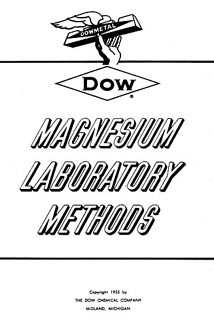 |
1955 Dow manual on magnesium laboratory analysis techniques |
During or shortly after World War II, Dow had developed a sublimation refining process under which magnesium was heated to vapor and condensed in a vacuum chamber. After three such cycles, the material, for all practical purposes, was pure magnesium with only the most minute residue of other elements. Busk supplied Craig with triply-sublimed material as a reference sample, and while doing so, mentioned Dow's earlier test of the Ubatuba material. In a letter to the author, Craig recalled that.
[P]ersonnel at the Dow laboratories were interested in UFO-related materials. They were most cooperative in furnishing pure magnesium samples and doing whatever analytical work I requested relating to the Ubatuba magnesium samples. I was surprised to learn that, years previously [possibly as early as 1958 - JC], they had done metallographic studies of the very samples of Ubatuba magnesium I was then asking them to analyze. They showed me the results of their earlier work, which they still had on file, and repeated the work for me.
Interestingly, Craig himself had worked for Dow for eight years at the Atomic Energy Commission's Rocky Flats Weapons Plant in Colorado, which was a Dow-managed facility that John Grebe had helped establish. Craig did not know Grebe, but they had mutual friends. He had never heard of the Midland case, and, perhaps not surprisingly, has no recollection of Condon describing any earlier involvement with UFO research. The neutron activation analysis Craig oversaw showed that, in contradiction to the Brazilian claims, the Ubatuba sample contained more impurities than the triply-sublimed sample, and could in fact have been made by terrestrial technology. Controversy over the significance of the particular constituents of the Ubatuba sample continues, as does analysis of the material using the latest techniques.
 |
1958 advertisement for Dow magnesium cruise missile components |
Grebe continued to work on nuclear projects at Dow until he retired. He died in Sun City, Arizona in 1984. His younger brother Carl, a scientist himself, recalls discussing flying saucers with John in the 1940s, and though they never discussed the Midland incident in detail, he agrees with John's former Dow colleagues that the spinning, self-destructing missile described in the Toftoy memo is exactly the kind of idea that Grebe's fertile mind would produce. The parallels between the Midland and Ubatuba incidents, separated by a decade and by thousands of miles, are striking. Were both incidents simply hoaxes, or is there still more to be learned about Ubatuba? Even Dr. Olavo Fontes observed, in his report on the Brazilian analysis of the Ubatuba fragments, that.
The mystery of that sudden explosion probably will never be solved. It may have been produced by the release of some self-destructing mechanism to prevent the machine from falling into our hands and thus giving us the chance to learn its secrets.
An updated version of this article is available on Project 1947.
Cochrane, Rexmond C., Measures for Progress. A History of the National Bureau of Standards, NBS Special Publication 275. Washington, DC: U.S. Government Printing Office, 1966
Ray Boundy and J. Lawrence Amos, eds, A History of the Dow Chemical Physics Lab: The Freedom to Be Creative. New York: Marcel Dekker. 1990
Brandt, E. N., Growth Company: Dow Chemical's First Century. East Lansing, MI: Michigan State University Press, 1997
US Air Force Project Blue Book "July 9, 1947 Midland, Michigan" case file
Col Holger Toftoy daily log, October 1948